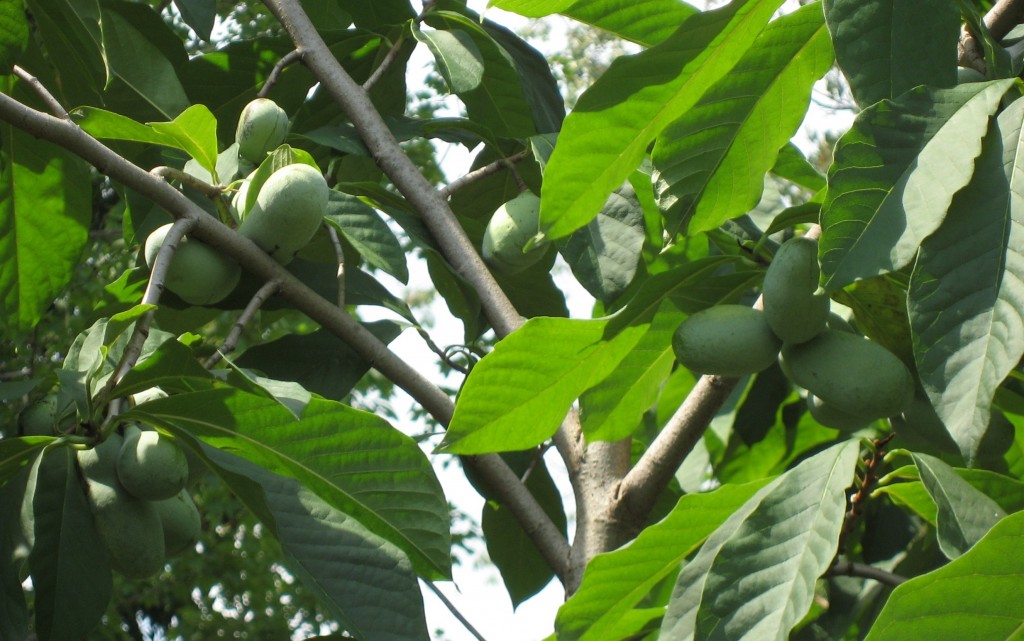Tip of the Week: The Underused, But Delicious, Pawpaw
Posted in Gardening Tips on August 30 2010, by Sonia Uyterhoeven
 |
Sonia Uyterhoeven is Gardener for Public Education. Join her each weekend for home gardening demonstrations on a variety of topics in the Home Gardening Center. |
 Lee Reich, author of The Pruning Book, an authoritative and accessible account of pruning techniques, gets part of his passion for pruning from his insatiable curiosity about and his desire to grow every type of fruit possible in the Northeast.
Lee Reich, author of The Pruning Book, an authoritative and accessible account of pruning techniques, gets part of his passion for pruning from his insatiable curiosity about and his desire to grow every type of fruit possible in the Northeast.
I was visiting his garden up in New Paltz in July and spent the day wandering through carefully caged and guarded blueberries (against the birds, not me) and arbors of grapes and hardy kiwis (Actinidia).The garden overflowed with fruit in all shapes and sizes ranging from alpine strawberries (Fragaria vesca) in containers and Nanking cherries (Prunus tomentosa) lining the driveway to medlars (Mespilus germanica) and cornelian cherries (Cornus mas) spotted around the garden.
One of the most breathtaking sites was his allée of pawpaws (Asimina triloba). They are small- to medium-size trees that grow to about 25 feet in height, with large, lush tropical foliage that is reminiscent of an avocado.
The flowers on the pawpaw have multiple ovaries so that the fruit grows in clusters. It needs to be cross-pollinated to bear fruit. If natural pollination isn’t occurring, you may want to hand pollinate by transferring the pollen from one plant to another with a small paint brush.
The pawpaw fruit looks like a small mango that starts out green and ripens to a speckled yellowish color in the fall. When the fruits are ripe they will soften and start to fall off the tree. The star attraction of the smooth-textured pawpaw is its indescribably delicious flavor—tasting like a combination of mango, pineapple, strawberry, banana, and vanilla custard that forms a tropical explosion in your mouth. You will either love it or hate it.
You can’t miss the seeds: They are big, brown, beanish-looking, and a bit of a nuisance to remove but not bad enough to deter you from eating the fruit, just a minor inconvenience. Because of their delicate nature, you will not find pawpaws in grocery stores, but perhaps you will at farmers markets in the fall.
Pawpaws can be grown in zones 4–8, according to Lee’s book Landscaping with Fruit. They can spread from underground roots, so you may have to occasionally run a lawn mower over the suckers to keep them from forming a thicket. This, generally, is not a big problem. Overall, pawpaws are low-maintenance trees that require minimal pruning and have no major pest or disease problems.
Named varieties of pawpaws provide the most reliable fruit, so buy a grafted tree. Some of Lee’s favorite varieties are ‘Mitchell’, ‘Overleese’, ‘Sunflower’, Taylor’, ‘Wells’, and ‘Zimmerman’. For more information on delectable fruits for your garden see his books, Landscaping with Fruit and Uncommon Fruits for Every Garden, both available at Shop in the Garden.


The paw paw is also the only host plant of the magnificent Zebra Swallowtail caterpillar. Surely another fabulous reason to plant some.
Eurytides marcellus